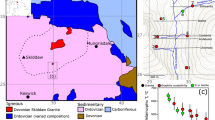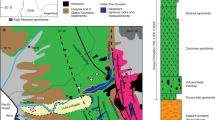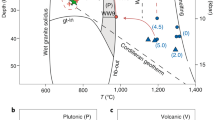Abstract
The origin of granites was once a question solely for petrologists and geochemists. But in recent years a consensus has emerged that recognizes the essential role of deformation in the segregation, transport and emplacement of silica-rich melts in the continental crust. Accepted petrological models are being questioned, either because they require unrealistic rheological behaviours of rocks and magmas, or because they do not satisfactorily explain the available structural or geophysical data. Provided flow is continuous, mechanical considerations suggest that—far from being geologically sluggish—granite magmatism is a rapid, dynamic process operating at timescales of ≤100,000 years, irrespective of tectonic setting.
This is a preview of subscription content, access via your institution
Access options
Subscribe to this journal
Receive 51 print issues and online access
$199.00 per year
only $3.90 per issue
Buy this article
- Purchase on Springer Link
- Instant access to full article PDF
Prices may be subject to local taxes which are calculated during checkout




Similar content being viewed by others
References
Taylor, S. R. & McLennan, S. M. The geochemical evolution of the continental crust. Rev. Geophys. 33, 241–265 (1995).
Brown, M. The generation, segregation, ascent and emplacement of granite magma: the migmatite-to-crustally-derived granite connection in thickened orogens. Earth Sci. Rev. 36, 83–130 (1994).
Petford, N., Clemens, J. D. & Vigneresse, J. L. in Granite: From Segregation of Melt to Emplacement Fabrics (eds Bouchez, J. L., Hutton, D. H. W. & Stephens, W. E.) 3–10 (Kluwer, Dordrecht, 1997).
Thompson, A. B. in Understanding Granites: Integrating New and Classical Techniques (eds Castro, A., Fernandez, C. Vigneresse, J. L.) 7– 25 (Geological Society of London Special Publication 158, 1999).
Thompson, A. B. & Connolly, J. A. D. Melting of the continental crust: some thermal and petrological constraints on anatexis in continental collision zones and other tectonic settings. J. Geophys. Res. 100, 15556–15579 (1995).
Huppert, H. E. & Sparks, R. S. J. The generation of granitic magmas by intrusion of basalt into continental crust. J. Petrol. 29, 599–642 ( 1988).
Bergantz, G. W. Underplating and partial melting: implications for melt generation and extraction. Science 254, 1039–1095 (1989).
Brown, M. & Rushmer, T. in Deformation-Enhanced Fluid Transport in the Earth's Crust and Mantle (ed. Holness, M.) 111– 144 (Chapman & Hall, London, 1997).
Vigneresse, J. L., Barbey, P. & Cuney, M. Rheological transitions during partial melting and crystallisation with application to felsic magma segregation and transfer. J. Petrol. 37, 1579–1600 ( 1996).
Clemens, J. D & Mawer, C. K. Granitic magma transport by fracture propagation. Tectonophysics 204, 339– 360 (1992).
Watt, G. R., Oliver, N. H. S. & Griffin, B. J. Evidence for reaction-induced microfracturing in granulite facies migmatites. Geology 28, 327–330 (2000).
Petford, N. & Koenders, M. A. Self-organisation and fracture connectivity in rapidly heated continental crust. J. Struct. Geol. 20, 1425–1434 ( 1998).
Dingwell, D. B., Bagdassarov, N. S., Bussod, G. Y. & Webb, S. L. in Experiments at High Pressure and Applications to the Earth's Mantle (ed. Luth, R. W.) 131–196 (Short course Vol. 21, Mineralogical Association of Canada, 1993).
Pitcher, W. S. The Nature and Origin of Granite (Blackie Academic, Glasgow, 1993).
Clemens, J. D. & Petford, N. Granitic melt viscosity and silicic magma dynamics in contrasting tectonic settings. J. Geol. Soc. Lond. 156, 1057–1060 (1999).
McKenzie, D. The generation and compaction of partially molten rocks. J. Petrol. 25, 713–765 ( 1984).
Wickham, S. M. The segregation and emplacement of granitic magmas. J. Geol. Soc. Lond. 144, 281–297 ( 1987).
Petford, N. Segregation of tonalitic-trondhjemitic melts in the continental crust: the mantle connection. J. Geophys. Res. 100, 15735–15743 (1995).
Kelemen, P. B. & Dick, H. J. B. Focused flow and localized deformation in the upper mantle: juxtaposition of replacive dunite and ductile shear zones in the Josephine peridotite, SW Oregon. J. Geophys. Res. 100, 423–438 (1995).
Rutter, E. H. & Neumann, D. H. K. Experimental deformation of partially molten Westerly granite under fluid-absent conditions with implications for the extraction of granitic magmas. J. Geophys. Res. 100, 15697–15715 (1995).
Davidson, C., Schmid, S. M. & Hollister, L. S. Role of melt during deformation in the deep crust. Terra Nova 6, 133–142 (1994).
Arzi, A. A. Critical phenomena in the rheology of partially molten rocks. Tectonophysics 44, 173–184 (1979).
Sawyer, E. W. Disequilibrium melting and the rate of melt-residuum separation during migmatisation of mafic rocks from the Grenville front, Quebec. J. Petrol. 32, 701–38 (1991).
Davies, G. R. & Tommasini, S. Isotopic disequilibrium during rapid crustal anatexis: implications for petrogenetic studies of magmatic processes. Chem. Geol. 162, 169– 191 (2000).
Clemens, J. D., Petford, N. & Mawer. C. K. in Deformation-Enhanced Fluid Transport in the Earth's Crust and Mantle (ed. Holness, M.) 145–172 (Chapman & Hall, Lond. 1997).
Petford, N., Kerr, R. C. & Lister, J. R. Dike transport of granitoid magmas. Geology 21, 845–848 ( 1993).
D'Lemos, R. S., Brown, M. & Strachan, R. A. Granite magma generation, ascent and emplacement within a transpressional orogen. J. Geol. Soc. Lond. 149, 487–490 (1993).
Collins, W. J & Sawyer, E. W. Pervasive granitoid magma transport through the lower-middle crust during non-coaxial compressional deformation. J. Metamorph. Geol. 14, 565– 579 (1996).
Weinberg, R. F. & Podladchikov, Y. Y. Diapiric ascent of magmas through power law crust and mantle. J. Geophys. Res. 99, 9543–9559 ( 1994).
Marsh, B. D. On the mechanics of igneous diapirism, stoping and zone melting. Am. J. Sci. 282, 808–855 (1982).
Brown, M & Solar, G. S. The mechanism of ascent and emplacement of granite magma during transpression: a syntectonic granite paradigm. Tectonophysics 312, 1–33 (1999).
Weinberg, R. F. Mesoscale pervasive felsic magma migration: alternatives to dyking. Lithos 46, 393–410 ( 1999).
Scalliet, B., Pecher, A., Rochette, P. & Champenois, M. The Gangotri granite (Garhwal Himalaya): laccolith emplacement in an extending collisional belt. J. Geophys. Res. 100, 585– 607 (1994).
Brandon, A. D., Chacko, T. & Creaser, R. A. Constraints on rates of granitic magma transport from epidote dissolution kinetics. Science 271, 1845–1848 (1996).
Petford, N. & Koenders, M. A. Granular flow and viscous fluctuations in low Bagnold number granitic magmas. J. Geol. Soc. Lond. 155, 873–881 (1998).
Hogan, J. P. & Gilbert, M. C. The A-type Mount Scott granite sheet: importance of crustal magma traps. J. Geophys. Res. 100, 15799–15792 (1995).
Hutton, D. H. W. Granite emplacement mechanisms and tectonic controls: inferences from deformation studies. Trans. R. Soc. Edinb.: Earth Sci. 79, 245–255 (1988).
Fernandez, C. & Castro, A. Pluton accommodation at high strain rates in the upper continental crust. The example of the Central Extremadura batholith, Spain. J. Struct. Geol. 21, 1143 –1149 (1999).
Benn, K., Odonne, F. & de Saint Blanquat, M. Pluton emplacement during transpression in brittle crust: new views from analogue experiments. Geology 26, 1079–1082 (1998).
Cruden, A. R. On the emplacement of tabular granites. J. Geol. Soc. Lond. 155, 853–862 (1998).
Roman-Berdiel, T., Gapais, D. & Brun, J. P. Granite intrusion along strike-slip zones in experiment and nature. Am. J. Sci. 297, 651– 678 (1997).
Brown, E. H. & McClelland, W. C. Pluton emplacement by sheeting and vertical ballooning in part of the southeast Coast Plutonic Complex, British Columbia. Geol. Soc. Am. Bull. 112, 708– 719 (2000).
Miller, R. B. & Paterson, S. R. In defence of magmatic diapirs. J. Struct. Geol. 21, 1161– 1173 (1999).
Grocott, J., Garde, A., Chadwick, B., Cruden, A. R. & Swager, C. Emplacement of Rapakivi granite and syenite by floor depression and roof uplift in the Paleoproterozoic Ketilidian orogen, South Greenland. J. Geol. Soc. Lond. 156, 15– 24 (1999).
Bouchez, J. L., Hutton, D. H. W. & Stephens, W. E. (eds) Granite: From Segregation of Melt to Emplacement Fabrics (Kluwer, Dordrecht, 1997).
Améglio, L. & Vigneresse, J. L. in Understanding Granites: Integrating New and Classical Techniques (eds Castro, A., Fernandez, C. & Vigneresse, J. L.) 39–54 (Geological Society of London Special Publication 158, 1999).
Evans, D. J. et al. Seismic reflection data and the internal structure of the Lake District batholith, Cumbria, northern England. Proc. Yorkshire Geol. Soc. 50, 11–24 ( 1994).
McCaffrey, K. J. W. & Petford, N. Are granitic intrusions scale invariant? J. Geol. Soc. Lond. 154, 1–4 (1997).
Atherton, M. P. Shape and intrusion style of the Coastal batholith, Peru. In 4th Int. Symp. on Andean Geodynamics (extended abstr.) 60– 63 (1999).
Bateman, P. C. Plutonism in the central part of the Sierra Nevada batholith, California. US Geol. Surv. Prof. Pap. 1483 ( 1992).
Cruden, A. R., Tobisch, O. T. & Launeau, P. Magnetic fabric evidence for conduit-fed emplacement of a tabular intrusion: Dinkey Creek pluton, central Sierra Nevada batholith, California. J. Geophys. Res. 104, 10511– 10530 (1999).
Harris, N., Vance, D. & Ayres, M. From sediment to granite: timescales of anatexis in the upper crust. Chem. Geol. 162, 155– 167 (2000).
Acknowledgements
We would like to thank M. Brown and A. Brandon for helpful reviews and J. Clemens and M. Atherton for useful discussions during the preparation of this manuscript.
Author information
Authors and Affiliations
Corresponding author
Rights and permissions
About this article
Cite this article
Petford, N., Cruden, A., McCaffrey, K. et al. Granite magma formation, transport and emplacement in the Earth's crust . Nature 408, 669–673 (2000). https://doi.org/10.1038/35047000
Issue Date:
DOI: https://doi.org/10.1038/35047000
This article is cited by
-
The Magma Emplacement of a Composite Volcanic-Intrusive System and Its Mineralization
Surveys in Geophysics (2024)
-
Diapirs of crystal-rich slurry explain granite emplacement temperature and duration
Scientific Reports (2023)
-
Study on the pore structure and radon emission characteristics of typical rocks in the Lintong area
Bulletin of Engineering Geology and the Environment (2023)
-
Geochemistry and petrogenesis of the Paleoproterozoic ortho-gneisses and granitoids of the Banded Gneissic Complex, central Rajasthan, NW India: Implications for crustal reworking processes
Acta Geochimica (2023)
-
Peraluminous A-type granites formed through synchronous fractionation, magma mixing, mingling, and undercooling: evidence from microgranular enclaves and host Mesoproterozoic Kanigiri granite pluton, Nellore Schist Belt, southeast India
Acta Geochimica (2023)
Comments
By submitting a comment you agree to abide by our Terms and Community Guidelines. If you find something abusive or that does not comply with our terms or guidelines please flag it as inappropriate.



